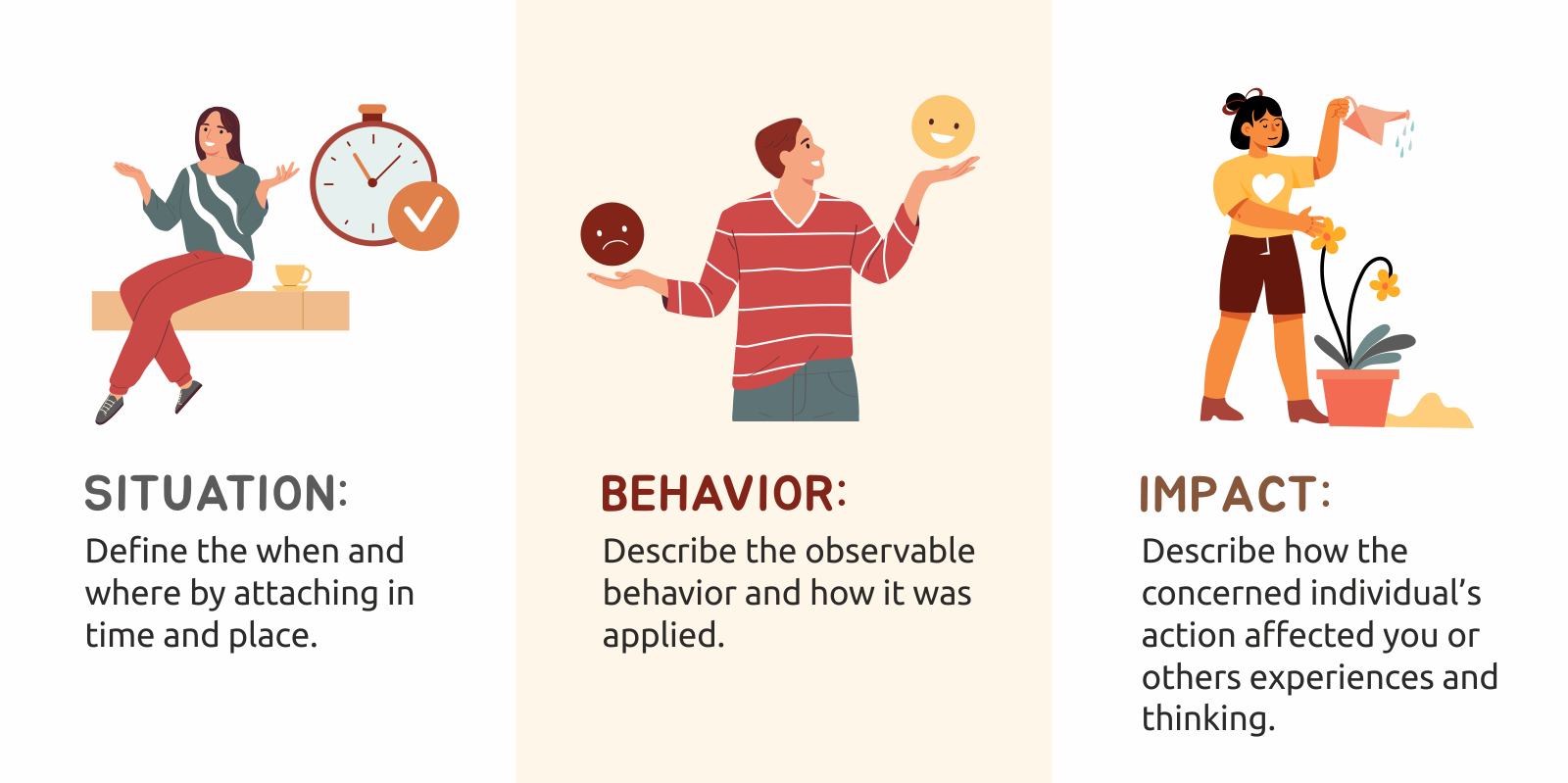Suggesting feedback

insecure sharing corrective feedback. This is because people are scared of damaging the relationship, being wrong, losing face or hurting concerned individual. Studies prove that corrective feedback is easier to embrace if you are in a good self-regulatory state and not tired or upset. Candidness is a crucial part of building trust. If you are able to notice something valuable that a person could improve on, it means you care.
Below are some tips to make a feedback flow:
- Evaluate the work and not the person. Do not use absolutes like: “You were wrong”, “You always…”, “You have a problem here”. Instead, provide an example such as: “This task was not completed within the agreed upon time and therefore we failed to provide the report on time”. Use the Situation-Behavior-Impact (S-B-I) model:
- Situation: Define the when and where by attaching in time and place.
- Behavior: Describe the observable behavior and how it was applied.
- Impact: Describe how the concerned individual’s action affected you or others experiences and thinking.
- Use I-messages. An I-message states the behavior and describes the speaker’s feelings or beliefs rather than focusing on the person spoken to. They are usually assertions made in a subdued manner. Contrarily, making statements such as “You did it all wrong again” will urge your listener to defend. You may use phrases “I feel …”, “I would like …”, etc. For instance, “I like that all issues are closed on time”. Avoid stating “I feel that you don’t…”, since such statements typically express judgment.
Following are main parts of an “I” Message:
- How you feel: “I feel, or I think…(state feeling)”
- What your feeling is about: “When you… (state observation)”
- Why you feel this way: “Because…(state the requirement)”
- What you would like to see instead: “I would prefer that…(state preference)”
For instance, “When you are late to our meetings, I feel disrespected/frustrated, since we cannot start our meetings on time. I would prefer that you join meetings during the agreed-upon time.”
Using statements such as “as you might have heard”, “unless you’ve been living in a cage you know”, “as everyone knows”, or “as I’ve already mentioned” causes negative result and might be perceived toxic. The people that aware don’t need it to be said. The people that unaware feel like they’ve missed something and might be anxious to ask about the context.
Remember the goal. When you provide feedback, your task is to help a person in improving his/her work and not to point out mistakes or criticize. This feedback approach will help a person grow and would not demotivate the individual.
Feedback examples
| Don’ts | Dos |
|---|---|
| “You always assign random names to the milestones” | “I noticed you created two milestones recently (situation) and assigned them very broad and vague names and descriptions (behavior) It is difficult for the team to understand the purpose of these milestones (impact).” |
| “You’re too quick to make decisions and your code is garbage” | “You were very quick to merge the last pull request, but it contained a mistake (situation and behavior) It caused confusion, since now I can’t understand what is the final version of the code (impact) …” |
If someone requests feedback from you and it is difficult for you to start, use the following three simple questions to organize your thoughts:
- What are the things that the concerned person can begin implementing or do more? Some examples are: “I wish that you would start…”, “I think it would be great to…”
- What do you think that the individual should stop doing? Examples: “I see/feel that (behavior) leads to (negative outcomes)”
- What do you think this person should keep doing? Examples: “I like the way…”, “I appreciate…”
Start-Stop-Continue approach will help you concentrate on behaviors and make the feedback more useful and practical. These categories are not mandatory and if you cannot find something that the person should stop doing, then drop it. The important thing is to avoid evaluating personality as it is not a subject for improvement.
Hit “Feedback” tag to discover more tips about feedback.
